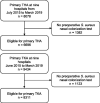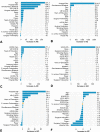Preoperative Colonization With Staphylococcus Aureus in THA Is Associated With Increased Length of Stay
- PMID: 35130192
- PMCID: PMC9278920
- DOI: 10.1097/CORR.0000000000002136
Preoperative Colonization With Staphylococcus Aureus in THA Is Associated With Increased Length of Stay
Abstract
Background: Staphylococcus aureus is a common organism implicated in prosthetic joint infection after THA and TKA, prompting preoperative culturing and decolonization to reduce infection rates. It is unknown whether colonization is associated with other noninfectious outcomes of THA or TKA.
Questions/purposes: (1) What is the association between preoperative S. aureus colonization (methicillin-sensitive S. aureus [MSSA] and methicillin-resistant S. aureus [MRSA]) and the noninfectious outcomes (discharge destination, length of stay, Hip/Knee Disability and Osteoarthritis Outcome Score [HOOS/KOOS] pain score, HOOS/KOOS physical function score, 90-day readmission, and 1-year reoperation) of THA and TKA? (2) What factors are associated with colonization with S. aureus ?
Methods: Between July 2015 and March 2019, 8078 patients underwent primary THA in a single healthcare system, and 17% (1382) were excluded because they were not tested preoperatively for S. aureus nasal colonization, leaving 6696 patients in the THA cohort. Between June 2015 and March 2019, 9434 patients underwent primary TKA, and 12% (1123) were excluded because they were not tested for S. aureus colonization preoperatively, leaving 8311 patients in the TKA cohort. The goal of the institution's standardized care pathways is to test all THA and TKA patients preoperatively for S. aureus nasal colonization; the reason the excluded patients were not tested could not be determined. Per institutional protocols, all patients were given chlorhexidine gluconate skin wipes to use on the day before and the day of surgery, and patients with positive S. aureus cultures were instructed to use mupirocin nasal ointment twice daily for 3 to 5 days preoperatively. Adherence to these interventions was not tracked, and patients were not rescreened to test for S. aureus control. The minimum follow-up time for each outcome and the percentage of the cohort lost for each was: for discharge destination, until discharge (0 patients lost); for length of stay, until discharge (0.06% [4 of 6696] lost in the THA group and 0.01% [1 of 8311] lost in the TKA group); for HOOS/KOOS pain score, 1 year (26% [1734 of 6696] lost in the THA group and 24% [2000 of 8311] lost in the TKA group); for HOOS/KOOS physical function, 1 year (33% [2193 of 6696] lost in the THA group and 28% [2334 of 8311] lost in the TKA group); for 90-day readmission, 90 days (0.06% [4 of 6696] lost in the THA group and 0.01% [1 of 8311] lost in the TKA group); and for 1-year reoperation, 1 year (30% [1984 of 6696] lost in the THA group and 30% [2475 of 8311] lost in the TKA group). Logistic regression models were constructed to test for associations between MSSA or MRSA and nonhome discharge, length of stay greater than 1 day, improvement in the HOOS/KOOS pain subscale (≥ the minimum clinically important difference), HOOS/KOOS physical function short form (≥ minimum clinically important difference), 90-day readmission, and 1-year reoperation. We adjusted for patient-related and hospital-related factors, such as patient age and hospital site. Variable significance was assessed using the likelihood ratio test with a significance level of p < 0.05. To assess factors associated with S. aureus colonization, we constructed a logistic regression model with the same risk factors.
Results: Among the THA cohort, after controlling for potentially confounding variables such as patient age, smoking status, and BMI, S. aureus colonization was associated with length of stay greater than 1 day (MSSA: odds ratio 1.32 [95% CI 1.08 to 1.60]; MRSA: OR 1.88 [95% CI 1.24 to 2.85]; variable p < 0.001 by likelihood ratio test) but not the other outcomes of THA. Male sex (OR 1.26 [95% CI 1.09 to 1.45]; p = 0.001) and BMI (OR 1.02 for a one-unit increase over median BMI [95% CI 1.01 to 1.03]; p = 0.003) were patient-related factors associated with S. aureus colonization, whereas factors associated with a lower odds were older age (OR 0.99 [95% CI 0.98 to 0.99]; p < 0.001) and Black race compared with White race (OR 0.64 [95% CI 0.50 to 0.82]; p < 0.001). Among the TKA cohort, S. aureus colonization was associated with 90-day readmission (MSSA: OR 1.00 [95% CI 0.99 to 1.01]; MRSA: OR 1.01 [95% CI 1.00 to 1.01]; variable p = 0.007 by likelihood ratio test). Male sex (OR 1.19 [95% CI 1.05 to 1.34]; p = 0.006) was associated with S. aureus colonization, whereas factors associated with a lower odds of colonization were older age (OR 0.99 [95% CI 0.98 to 0.99]; p < 0.001), Veterans RAND-12 mental component score (OR 0.99 [95% CI 0.99 to 1.00]; p = 0.027), Black race compared with White race (OR 0.70 [95% CI 0.57 to 0.85]; p < 0.001), and being a former smoker (OR 0.86 [95% CI 0.75 to 0.97]; p = 0.016) or current smoker (OR 0.70 [95% CI 0.55 to 0.90]; p = 0.005) compared with those who never smoked.
Conclusion: After controlling for the variables we explored, S. aureus colonization was associated with increased length of stay after THA and 90-day readmission after TKA, despite preoperative decolonization. Given that there is little causal biological link between colonization and these outcomes, the association is likely confounded but may be a proxy for undetermined social or biological factors, which may alert the surgeon to pay increased attention to outcomes in patients who test positive. Further study of the association of S. aureus colonization and increased length of stay after THA and readmission after TKA may be warranted to determine what the confounding variables are, which may be best accomplished using large cohorts or registry data.
Level of evidence: Level III, therapeutic study.
Copyright © 2022 by the Association of Bone and Joint Surgeons.
Conflict of interest statement
All ICMJE Conflict of Interest Forms for authors and Clinical Orthopaedics and Related Research® editors and board members are on file with the publication and can be viewed on request.
Figures



Comment in
-
CORR Insights®: Preoperative Colonization With Staphylococcus Aureus in THA is Associated With Increased Length of Stay.Clin Orthop Relat Res. 2022 Aug 1;480(8):1515-1517. doi: 10.1097/CORR.0000000000002172. Epub 2022 Mar 8. Clin Orthop Relat Res. 2022. PMID: 35258499 Free PMC article. No abstract available.
-
Letter to the Editor: Preoperative Colonization With Staphylococcus Aureus in THA Is Associated With Increased Length of Stay.Clin Orthop Relat Res. 2023 Jun 1;481(6):1250-1251. doi: 10.1097/CORR.0000000000002646. Epub 2023 Apr 4. Clin Orthop Relat Res. 2023. PMID: 37017590 Free PMC article. No abstract available.
References
-
- Burnham KP, Anderson DR. Multimodel inference: understanding AIC and BIC in model selection. Sociol Methods Res. 2004;33:261-304.
-
- Campbell KA, Cunningham C, Hasan S, Hutzler L, Bosco JA, 3rd. Risk factors for developing Staphylococcus aureus nasal colonization in spine and arthroplasty surgery. Bull Hosp Jt Dis. 2015;73:276-281. - PubMed
-
- Kent SE, Schneider GB, Hollenbeck BL, Vlad SC. Risk factors for Staphylococcus aureus colonization in a presurgical orthopedic population. Am J Infect Control. 2019;47:902-905. - PubMed
MeSH terms
LinkOut - more resources
Full Text Sources
Medical
Research Materials

